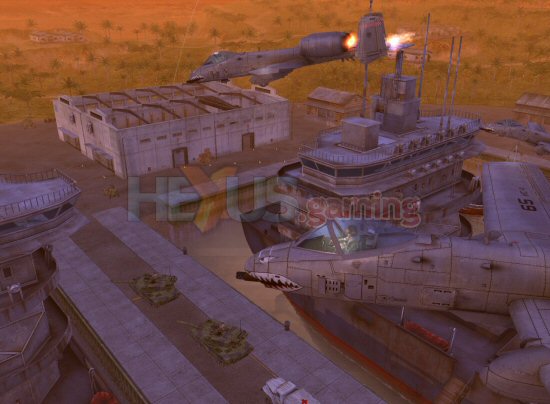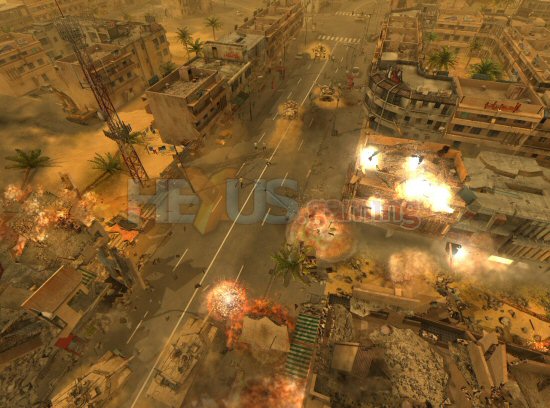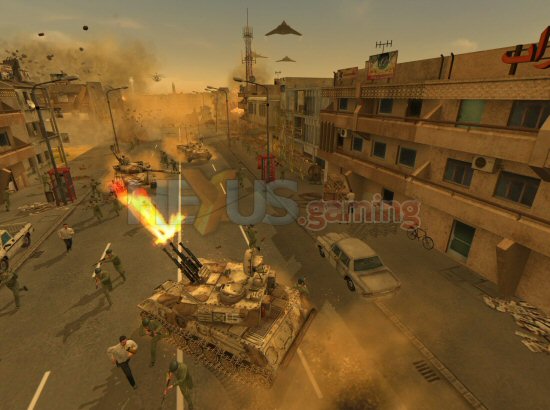Great interface, cool units..
So, how does Joint Task Force play? Well, like pretty much any RTS out there, nearly the entire game can be controlled with just the mouse. The usual rules apply, left click to select a unit, or left click and drag to select a group of units and right click to move or order an attack etc. Moving the mouse to the edge of the screen scrolls the view and of course you’ve got the full spinny-rotaty zoom in and out-ness of a decent 3D graphics engine too.
 Click for larger image
Click for larger imageUnusually for an RTS, there’s no resource points to conquer and hold, mining facilities to build or weird nuclear extraction methadone production plants to defend. Remember, this is a near-future RTS, so your resource for the game is hard cash. So unlike the real world where, if you were American, your job would be to secure the oilfields while the hospitals and government buildings could be happily pillage by the rioters, Joint Task Force sees you judged on your performance by the ever watching media. The better you perform with the less ‘collateral damage’ the more funding you receive. In other words, if you go in with all guns blazing, wasting civilians and razing entire villages to the ground, the world will be aghast with horror and your funding is severely cut for the next mission. Funny how real life is so different, eh?
The idea of having 24/7 media coverage as a resource is inspired as this actually affects the way you play Joint Task Force. Not only do you have to think tactically, but you now have to think humanely as well. Sure, you could carpet bomb that entire suburb to take out the two snipers and the enemy tank but you’ll then find yourself with just enough cash to buy small penknife for the next mission and unless you’re Rambo, that’s not going to do you much good.
 Click for larger image
Click for larger imageEach mission sees you start off with a basic squad which, as you progress through the game, increases in size and variety of units until you’re commanding choppers, ground attack aircraft, tanks, humvees and, of course, infantry. Central to all this is the commander, who’s a ‘hero’ type, with different commanders giving different bonuses to nearby troops. Your commander is also your interface for calling in more troops and adding different units to your squad, and by making the right tactical decisions, fighting a fair fight and letting the civilian population carry on as normally as possible, you should find the funds continue to flow, letting you call in a wide variety of units.
Now, out in the field, you’re limited to only being able to call in units that can be choppered in. So that covers all your actual soldiers, from rangers and marksmen through to engineers and vehicle crews. You can also call in extra equipment for your troops such as mine detectors, rocket launchers and night vision goggles. Vehicle wise, you can get a friendly Black Hawk to drop off a Humvee and you can call in the AH-6 light attack helicopter as well as the awesome AH-64 Apache, which you then command as part of your team.
 Click for larger image
Click for larger imageTo get the good stuff, the really heavy weaponry, you need to take over and hold an airfield as stuff like the M1A2 Main Battle Tank and mobile artillery are just too damn heavy for a helicopter to lift. So grabbing an airfield means you can then buy a few tanks and have them dropped in by plane onto the runway. The only problem with this type of resupply is that you can sometimes find yourself with a rather extended supply chain… vehicles drop off on the runway then have to have a good trundle across the map to get where they’re needed. On the flip side, given that many missions develop as you progress through them, it does give a good feel for what a rapidly changing mobile engagement would feel like as you try and second guess what you’re going to need later on.
 Click for larger image
Click for larger image








